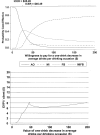Cost-effectiveness analysis of motivational interviewing with feedback to reduce drinking among a sample of college students
- PMID: 22333330
- PMCID: PMC3281981
- DOI: 10.15288/jsad.2012.73.226
Cost-effectiveness analysis of motivational interviewing with feedback to reduce drinking among a sample of college students
Abstract
Objective: This study evaluated the costs and cost-effectiveness of combining motivational interviewing with feedback to address heavy drinking among university freshmen.
Method: Microcosting methods were used in a prospective cost and cost-effectiveness study of a randomized trial of assessment only (AO), motivational interviewing (MI), feedback only (FB), and motivational interviewing with feedback (MIFB) at a large public university in the southeastern United States. Students were recruited and screened into the study during freshman classes based on recent heavy drinking. A total of 727 students (60% female) were randomized, and 656 had sufficient data at 3-months' follow-up to be included in the cost-effectiveness analysis. Effectiveness outcomes were changes in average drinks per drinking occasion and number of heavy drinking occasions.
Results: Mean intervention costs per student were $16.51 for MI, $17.33 for FB, and $36.03 for MIFB. Cost-effectiveness analysis showed two cost-effective interventions for both outcomes: AO ($0 per student) and MIFB ($36 per student).
Conclusions: This is the first prospective cost-effectiveness study to our knowledge to examine MI for heavy drinking among students in a university setting. Despite being the most expensive intervention, MIFB was the most effective intervention and may be a cost-effective intervention, depending on a university's willingness to pay for changes in the considered outcomes.
Figures



References
-
- Agostinelli G, Brown JM, Miller WR. Effects of normative feedback on consumption among heavy drinking college students. Journal of Drug Education. 1995;25:31–40. - PubMed
-
- Arnett JJ. The developmental context of substance use in emerging adulthood. Journal of Drug Issues. 2005;35:235–253.
-
- Bachman JG, Wadsworth KN, O’Malley PM, Johnston LD, Schulenberg J. Smoking, drinking, and drug use in young adulthood: The impacts ofnew freedoms and new responsibilities. Mahwah, NJ: Lawrence Erlbaum; 1997.
-
- Barbosa C, Godfrey C, Parrott S. Methodological assessment of economic evaluations of alcohol treatment: What is missing? Alcohol and Alcoholism. 2010;45:53–63. - PubMed
Publication types
MeSH terms
Grants and funding
LinkOut - more resources
Full Text Sources
Medical

